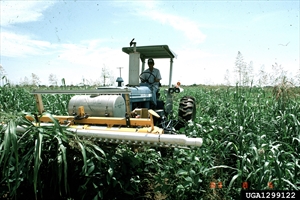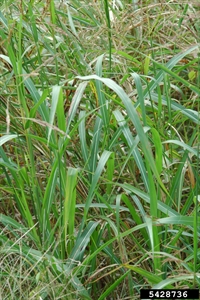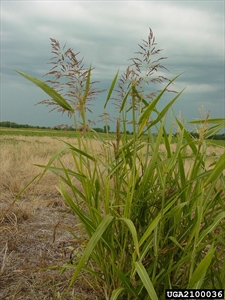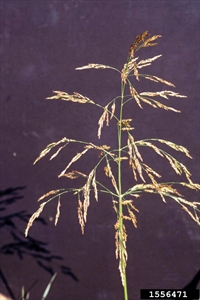- Worldwide distribution. In Australia, New Zealand, most Pacific island countries.
- Major invasive weed. Produces abundant seed. Invades many crops (e.g., cotton, maize, soybean, sugarcane), wastelands, natural vegetation, roadsides; spreads pests (midge, viruses, fungi, bacteria); toxic to livestock (especially after drought); fire risk. Allergenic pollen. Produces root chemicals inhibiting competitors.
- Numerous erect stems up to 3m, from extensive, purple-spotted scaly, rhizomes. Leaves hairless with prominent white midribs. Pale green-purplish, branched flower seedheads, up to 35cm. Spikelets (flowers) in pairs or triplets along and at end of branches.
- Spread: rhizomes and seed on the wind, water, seed lots, fodder, vehicles. Rhizomes assist survival.
- Biosecurity: check for seed in livestock fodder, maize and sorghum seeds.
- Biocontrol: none.
- Cultural control: hand-weed; plough; mow (but rhizomes regrow); heavy grazing to deplete reserve; geese; fire (follow-up with herbicide). Clean machinery/vehicles; check clothing; quarantine livestock 1 week between infested and ‘clean’ pastures. Avoid seed-infested soil, sand, gravel.
- Chemical control: in Australia, butroxydim; clethodim; glufosinate-ammonium; glyphosate; haloxyfop; imazapyr; oxyfluorfen; quizalofop-p-ethyl; trifluralin; diquat + paraquat.
Pacific Pests, Pathogens and Weeds - Online edition
Pacific Pests, Pathogens, Weeds & Pesticides
Johnson grass (487)
Johnson grass. It is also known as Aleppo grass, false guinea grass.
Sorghum halepense; previously known as Andropogon halepensis, and Holcus halepensis. It is a member of the Poaceae.
AUTHOR Grahame Jackson
Information from Sorghum halapense (L.) Pers. (2020) Weeds Australia - Profiles. Centre for Invasive Species Solutions, Department of Agriculture, Water and the Environment. Australian Government. (https://profiles.ala.org.au/opus/weeds-australia/profile/Sorghum%20halepense); and CABI (2019) Sorghum halepense (Johnson grass). Crop Protection Compendium. (https://www.cabi.org/cpc/datasheet/50624); and from Johnson grass (Sorgun halepense) (2017) NSW WeedWise. Department of Primary Industries. NSW Government. (https://weeds.dpi.nsw.gov.au/Weeds/Details/74). Photos 1&7 Charles T. Bryson, USDA, USDA Agricultural Research Service, Bugwood.org. Photo 2 John D. Byrd, Mississippi State University, Bugwood.org. Photo 3&6 Steve Dewey, Utah State University, Bugwood.org. Photo 4 Ohio State Weed Lab , The Ohio State University, Bugwood.org. Photo 5 Karan A. Rawlins, University of Georgia, Bugwood.org. Photo 8 John Cardina, The Ohio State University, Bugwood.org. Photo 9 Lynn Sosnoskie, University of Georgia, Bugwood.org.
Produced with support from the Australian Centre for International Agricultural Research under project HORT/2016/185: Responding to emerging pest and disease threats to horticulture in the Pacific islands, implemented by the University of Queensland and the Secretariat of the Pacific Community.












